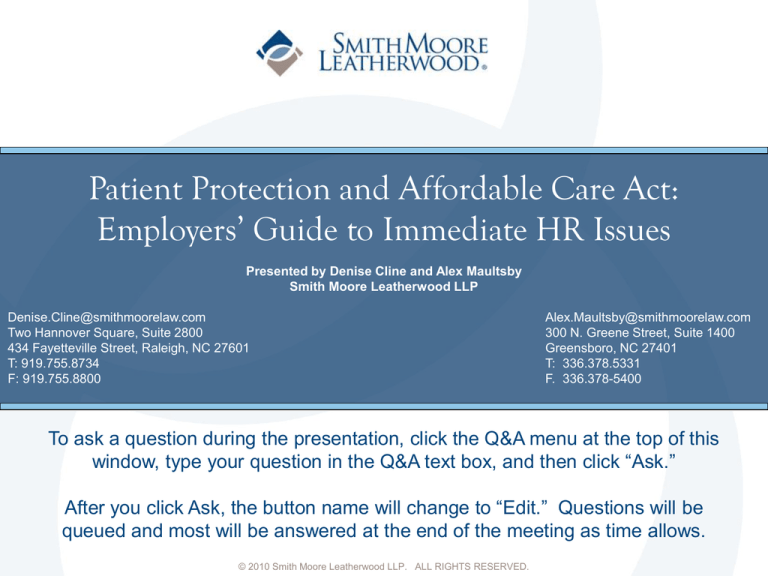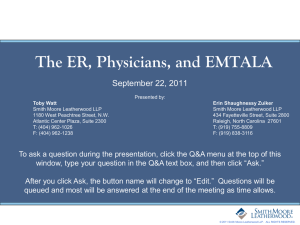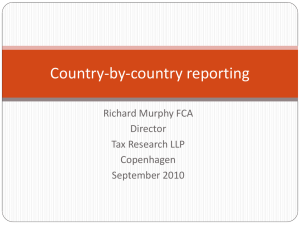
Patient Protection and Affordable Care Act:
Employers’ Guide to Immediate HR Issues
Presented by Denise Cline and Alex Maultsby
Smith Moore Leatherwood LLP
Denise.Cline@smithmoorelaw.com
Two Hannover Square, Suite 2800
434 Fayetteville Street, Raleigh, NC 27601
T: 919.755.8734
F: 919.755.8800
Alex.Maultsby@smithmoorelaw.com
300 N. Greene Street, Suite 1400
Greensboro, NC 27401
T: 336.378.5331
F. 336.378-5400
To ask a question during the presentation, click the Q&A menu at the top of this
window, type your question in the Q&A text box, and then click “Ask.”
After you click Ask, the button name will change to “Edit.” Questions will be
queued and most will be answered at the end of the meeting as time allows.
© 2010 Smith Moore Leatherwood LLP. ALL RIGHTS RESERVED.
Presentation Will Cover
• Immediate Coverage Requirements
• Notification Requirements
• Changes in Fair Labor Standards
Act: Nursing Mother
Accommodations
• New Whistleblower Protections
• Nursing Facility Disclosures
®
© 2010 Smith Moore Leatherwood LLP. ALL RIGHTS RESERVED.
Immediate Coverage Requirements
September 23, 2010 Trigger Date for All Plans
•
•
•
•
•
•
No lifetime benefit caps
Restrictions on annual limits (essential health benefits)
Dependent coverages expanded
No exclusions for children’s pre-existing conditions
Tougher rescission laws
Limits on reimbursement accounts
®
© 2010 Smith Moore Leatherwood LLP. ALL RIGHTS RESERVED.
Immediate Coverage Requirements
The Grandfather Issue—Why does it matter?
• What can defeat grandfathered status:
– Reduced benefits
– Increased costs
– Lower employer contributions
– Less favorable annual limits
– Self-funded to fully insured
• Is it worth it?
®
© 2010 Smith Moore Leatherwood LLP. ALL RIGHTS RESERVED.
Immediate Coverage Requirements
So, if NOT grandfathered:
• Dependent coverage through age 26, even if other
coverage is available
• No annual limits on essential benefits
• No co-pays for certain preventive care costs
• Cover emergency care regardless of provider
• No pre-authorization requirements for OB/GYN and
emergency services
• Anti-discrimination rules apply
®
© 2010 Smith Moore Leatherwood LLP. ALL RIGHTS RESERVED.
Notification Requirements
• Beginning in 2011,
large employers must
report whether they will
offer employees the
opportunity to enroll in
minimum essential
coverage under
employer sponsored
plan.
®
© 2010 Smith Moore Leatherwood LLP. ALL RIGHTS RESERVED.
2011 Required Notifications
• Length of applicable waiting periods for coverage
• Lowest cost option in each enrollment category under
the plan
• Employer’s share of the total allowed cost option in each
category
• Number and names of full time employees receiving
coverage
®
© 2010 Smith Moore Leatherwood LLP. ALL RIGHTS RESERVED.
Notifications Required in 2012
• Beginning in 2012, employers
must disclose the value of
employees’ health insurance
benefits on annual W-2.
• Covers tax year 2011, so
tracking begins soon.
®
© 2010 Smith Moore Leatherwood LLP. ALL RIGHTS RESERVED.
By March 31, 2013, Employers Must
Notify Employees . . .
• About state health insurance exchanges
• Whether the employer’s plan meets the minimum
coverage requirements
• How to access information about applying for premium
subsidies under the exchange-based coverage
®
© 2010 Smith Moore Leatherwood LLP. ALL RIGHTS RESERVED.
Breastfeeding Protections
• Section 2407 amends Section 7 of
the Fair Labor Standards Act by
requiring that employers provide
nursing mothers with reasonable
lactation breaks.
• Presumed to be effective
immediately
®
© 2010 Smith Moore Leatherwood LLP. ALL RIGHTS RESERVED.
Who’s Entitled to Breaks?
• Although some states required breaks before, neither
federal nor NC law required breaks for adult workers
prior to PPACA.
• PPACA now amends Section 7 of FLSA .
• Applies to non-exempt employees, not exempt
employees
®
© 2010 Smith Moore Leatherwood LLP. ALL RIGHTS RESERVED.
What About Exempt Employees?
• Employers may provide similar breaks for exempt
employees.
• If provided, employers should not deduct break time
from compensation for exempt employers.
®
© 2010 Smith Moore Leatherwood LLP. ALL RIGHTS RESERVED.
Small Employer Exemption
• Employers with fewer than 50 employees are exempt
from the statute’s requirements if doing so would impose
an “undue hardship.”
• Undue hardship is analyzed by weighing the significant
difficulty or expense against the “size, financial
resources, nature, or structure of the employers’
business.”
®
© 2010 Smith Moore Leatherwood LLP. ALL RIGHTS RESERVED.
What’s Required?
• Section 2407 requires employers to provide nursing
mothers with a reasonable break time “each time such
employee has need to express the milk.”
• Employees are entitled to these breaks for one year from
the child’s birth.
®
© 2010 Smith Moore Leatherwood LLP. ALL RIGHTS RESERVED.
What’s Reasonable?
• PPACA provides no specific limit on length of breaks.
• No limit on the number of breaks allowed
• Note: Employers cannot regulate either the frequency or
timing of these breaks.
®
© 2010 Smith Moore Leatherwood LLP. ALL RIGHTS RESERVED.
Paid or Unpaid?
• If lactation break is taken during work time, no
compensation for work time is required.
• That is, unless state law dictates otherwise as in Ala,
CA,CO, CN, GA, IL, IN, ME, MN, MT, NM, NY, OK, OR,
RI, TN, or VT
• If it’s more protective, state law will govern.
®
© 2010 Smith Moore Leatherwood LLP. ALL RIGHTS RESERVED.
Do Breaks Count as “Time
Worked?”
• Although prior law did not require
breaks, if provided, regulations
specified that breaks of 5 to 20
minutes should be counted as
time worked.
• Similarly, lunch breaks if shorter
than 30 minutes, were counted
as time worked.
• No regulations on lactation
breaks yet
®
© 2010 Smith Moore Leatherwood LLP. ALL RIGHTS RESERVED.
Location, Location…
• Under § 2407, employers must
provide a “private place”
shielded from view and free
from intrusion.
• Private location is not defined,
but it cannot be a bathroom.
®
© 2010 Smith Moore Leatherwood LLP. ALL RIGHTS RESERVED.
State or Federal Law?
• Follow the most protective.
• Use care if you have multistate locations.
• Employees should receive copies of revised break
policies in advance.
®
© 2010 Smith Moore Leatherwood LLP. ALL RIGHTS RESERVED.
What Your Policy Should Provide
• Establish entitlement to lactation (or any other) breaks.
• Specify how lactation break time is treated in terms of
pay and time worked.
• Set forth procedure for requesting and documenting
time.
• Set forth commitment to provide private, non-bathroom
place for lactation breaks (and follow up).
®
© 2010 Smith Moore Leatherwood LLP. ALL RIGHTS RESERVED.
Penalties
• Not clear what if any penalties result from failure to abide
by requirement
• Existing state law may provide for money damages, but
since lactation breaks are not required to be
compensated, not clear if money damages are
recoverable for violation of federal law.
®
© 2010 Smith Moore Leatherwood LLP. ALL RIGHTS RESERVED.
Interesting Issues
• Can you temporarily transfer a nursing mother?
• Does time taken for multiple daily nursing breaks count
towards 40 hour work week?
• What about accessibility and other issues such as
mothers who cannot express milk easily or at all?
• What happens when there are multiple nursing mothers
in a single workplace?
®
© 2010 Smith Moore Leatherwood LLP. ALL RIGHTS RESERVED.
Whistleblower Protection
• Section 1558 of the
PPACA prohibits
retaliation against
employees who provide
information that the
employee believes to
be a violation of
PPACA, Title I.
®
© 2010 Smith Moore Leatherwood LLP. ALL RIGHTS RESERVED.
Whistleblower Protections Include:
• Retaliation protection added to the Fair Labor Standards
Act
• Abuse reporting protections for federally funded nursing
facility employees
• Mandatory implementation of standard complaint
process for nursing home residents and representatives
• Expansion of rights under False Claims Act
®
© 2010 Smith Moore Leatherwood LLP. ALL RIGHTS RESERVED.
Whistleblower Protection is Broad
Protection is available for employees who
provide or who are “about to” provide an
employer, the federal government or a
state attorney general with information
about violations of Title I.
®
© 2010 Smith Moore Leatherwood LLP. ALL RIGHTS RESERVED.
What’s in Title I?
• Title I includes a broad range of provisions on
quality improvements in health care, significant
changes in health insurance coverage,
availability, and affordability.
• Title I includes the most significant changes in
insurance coverage requirements for employers
and individuals.
• Title I also includes state exchange
requirements.
®
© 2010 Smith Moore Leatherwood LLP. ALL RIGHTS RESERVED.
Whistleblower Protections Favor
Employees
• Burden of proof under Section 1558 favors employees.
• Employee must show that the complainant’s activity was
a contributing factor to the employer’s adverse action.
• Employees must file a complaint with OSHA within 180
days or the retaliatory action.
®
© 2010 Smith Moore Leatherwood LLP. ALL RIGHTS RESERVED.
Protections for Patient Abuse
• Section 6703(b)(3) of PPACA requires that long term
care facilities receiving more than $10,000 in federal
funding must provide notification of reporting obligations.
• Notification should inform employees, etc., that they
must report to Dept of Health and Human Services any
reasonable suspicion of a crime against a resident or
person receiving care.
®
© 2010 Smith Moore Leatherwood LLP. ALL RIGHTS RESERVED.
Who Must Be Notified?
• Officers
• Managers
• Employees
• Contractors
®
© 2010 Smith Moore Leatherwood LLP. ALL RIGHTS RESERVED.
Transparency Reports
• Owners of nursing
facilities are affected
by Subtitle B of Title
VI, entitled Nursing
Home Transparency
and Improvement.
• At the federal level
more disclosure
about ownership
and governance will
be required.
®
© 2010 Smith Moore Leatherwood LLP. ALL RIGHTS RESERVED.
What Must be Disclosed?
• Section 6101 requires disclosure of the following “disclosable
parties.”
– Identity of members of the governing body, their title and period
of service
– Identity of officers, directors, partners trustees, etc., their titles,
and period of service
– Managing employees
• Any “additional disclosable party” must disclose its “organizational
structure” and its relationship to the facility and each other.
®
© 2010 Smith Moore Leatherwood LLP. ALL RIGHTS RESERVED.
Who Are “Additional Disclosable
Parties?”
• Each person or entity that exercised operational,
financial or managerial control
• Each person or entity that provides financial or cash
management
• Entities that lease or sublease real property to the facility
• Entities that own more than 5% of the value of the real
property
®
© 2010 Smith Moore Leatherwood LLP. ALL RIGHTS RESERVED.
Additional Disclosable Parties
• Persons or entities that provide
management or administrative
services, management of clinical
consulting services
®
© 2010 Smith Moore Leatherwood LLP. ALL RIGHTS RESERVED.
Definition of “Organizational
Structure”
• For corporation, officers, directors and shareholders who own more
than 5%
• For limited liability companies, members and managers, including %
ownership
• For general partnerships, the partners
• For limited partnerships, general partners and limited partners with
more than 10% interest
• For a trust, the trustees
• For individuals, contact information
®
© 2010 Smith Moore Leatherwood LLP. ALL RIGHTS RESERVED.
Screening Procedures
• HHS must establish procedures for screening all
providers for level of risk for fraud, waste and abuse.
• Providers must also pay $500 if selected for screening.
• Screening will include licensure and background checks,
fingerprinting, on-site visits and database checks.
®
© 2010 Smith Moore Leatherwood LLP. ALL RIGHTS RESERVED.
Possible Effects of Additional
Reporting Requirements
• Longer time to enroll in programs
• Reluctant disclosable entities
• Public access to ownership information may affect
litigation
• False certifications may result in liability under federal
False Claims Act
®
© 2010 Smith Moore Leatherwood LLP. ALL RIGHTS RESERVED.
Standard Complaint Process for
Nursing Facility Residents
• Section 6105 amends the
Social Security Act by requiring
states to make available to
residents of nursing facilities
standard federal complaint
forms.
• This section also requires
states to establish a complaint
resolution process to track
complaints and prevent
retaliation.
®
© 2010 Smith Moore Leatherwood LLP. ALL RIGHTS RESERVED.
PPACA and Other HR Laws
PPACA may intersect with other HR related laws and
requirements such as:
• Americans with Disabilities Act Amendment Act
(ADAAA)--expanded coverage of dependents and those
with preexisting conditions may lead to more claims of
discrimination
• COBRA issues----does PPACA eliminate or expand
COBRA coverage for employees or dependents?
• Discrimination issues---phase-in of mandatory coverage
may lead to discrimination claims based on required
future coverage
®
© 2010 Smith Moore Leatherwood LLP. ALL RIGHTS RESERVED.
What You Know May Hurt You…
• Greater coverage can result in more health related
information for employers to handle, secure and dispose
• Access to more information may result in inadvertent
violations of HIPAA, Genetic Information
Nondiscrimination Act (GINA)
• As always, watch out for general discrimination issues,
including pregnancy, gender, genetic, ethnic and age
discrimination
®
© 2010 Smith Moore Leatherwood LLP. ALL RIGHTS RESERVED.
How Human Resources
Professionals Can Prepare
• Create policies for lactation and other breaks
• Work with health insurance providers on immediate
changes required for plans
• Create notification language and calendar deadlines for
employee notification requirements
• Keep updated on regulations as issued
• Train supervisors and others on whistleblower issues
• Implement system and form for nursing home notification
and transparency requirements
®
© 2010 Smith Moore Leatherwood LLP. ALL RIGHTS RESERVED.
Questions
®
© 2010 Smith Moore Leatherwood LLP. ALL RIGHTS RESERVED.












